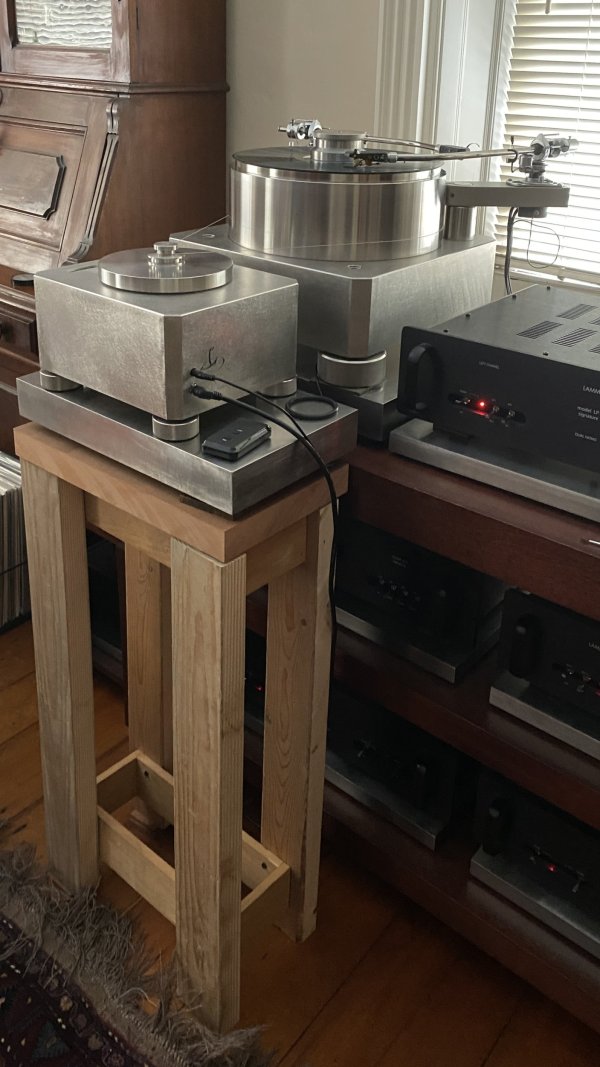I installed a duplicate vintage Ortofon cartridge on my second SME 3012R tonearm last weekend. I set up the two arm/cartridge combinations to sound very close to each other, and they do despite one using the vintage Ortofon SUT into the MM input and the other using the internal SUT on my Lamm LP1 phono stage. I followed the set up method that David Karmeli taught me and used the LP he supplied to fine tune by ear.
Once satisfied with the results, I used a digital scale to measure LP weight. The set up LP is 180g. I checked some random LPs in my listening room and they measured 120, 135, 150, and 180g. Fellow WBF member MAXPWR sent me the chart copied below comparing record weight with thickness. As those who have read about DDK's method for arm height adjustment know, David uses standard playing cards stacked and placed between the bottom of the arm base and the locking collar lower on the post. A standard playing card is 0.2mm thick. This corresponds roughly with a thickness difference between 160g and 180g LPs.
Some may think that a standard playing card is too course of an adjustment, but remember, Michael Fremer noted that one must raise a typical 9" arm 4.0mm to achieve a difference of 1 degree in SRA. He also recommends a 92 degree SRA which I ignore. A playing card is 1/20th of that, or 1/20th of 1 degree. It is even less for a 12" tonearm because of the extra length. Fine tuning beyond that 1/20th of a degree can be done with very slight changes in VTF, or by using small even thinner pieces of paper instead of playing cards. All this for the SME 3012R. Other arms have different methods.
I optimized the set up of both identical arm/cartridge combinations for that 180g LP by listening for the most natural presentation. I am now adjusting one of the two arms for thinner LPs with promising results. Lowering the arm by two (2) playing cards, or 0.4mm, corresponds with a record weight of 145g. Three (3) cards is roughly a 130g LP. I plan to adjust by ear, not just by following the chart, but it seems to be a nice ballpark and seems to get one pretty close, once a correct height is determined with a record of known weight.
There are other factors involved. Cutting angle varies. Groove thickness might be a factor too, though I do not know. Given my results so far, I think I will be using two identical arm/cartridge combinations on my table for a while, set up for thicker (180g) and thinner (140-150g) records. If I find I have more records in the 110-120g range, I may set the second arm up for that thickness. I may even adjust one card up or down for the two different thinner record weights. I suppose I could add a third arm with my third Ortofon, but I would likely use a third arm for a different cartridge.
I definitely hear an improvement in the presentation with different set ups for different record thicknesses. The presentation sounds clearer, more focused, more lively and full of energy, timbre is more believable, nuance and ambiance are improved, and overall, it just sounds more correct or natural when adjusted for the specific LP weight being played. I wish it were not so, but I hear it clearly. The result is a similar quality of presentation on a variety of records. I have yet to do a direct comparison between a thick and thin LP of the same recording, though even there, the remastering will change the way it sounds.
If I decide to reinstall one of my Colibris, it will likely be for thinner LPs because most of my large scale classical LPs are thin and they benefit from the slightly greater resolution of the Colibris, but that is for later. Now I am simply enjoying two arms with the Ortofon, one optimized for thick records, and one for thin records.
In my old system, I used to adjust arm height for each record. That was a lot of work. I think having two arms set up for thicker and thinner records is a nice solution to the issue of varying thicknesses. A greater variety of records now sound better on my system. Unfortunately, the lack of standardization in record thickness, creates a problem for those of us who want to optimize arm set up for the best presentation in our rooms.
LP thickness chart:




